1lumen selects and reviews products personally. We may earn affiliate commissions through our links, which help support our testing.
Nitecore MH12S review
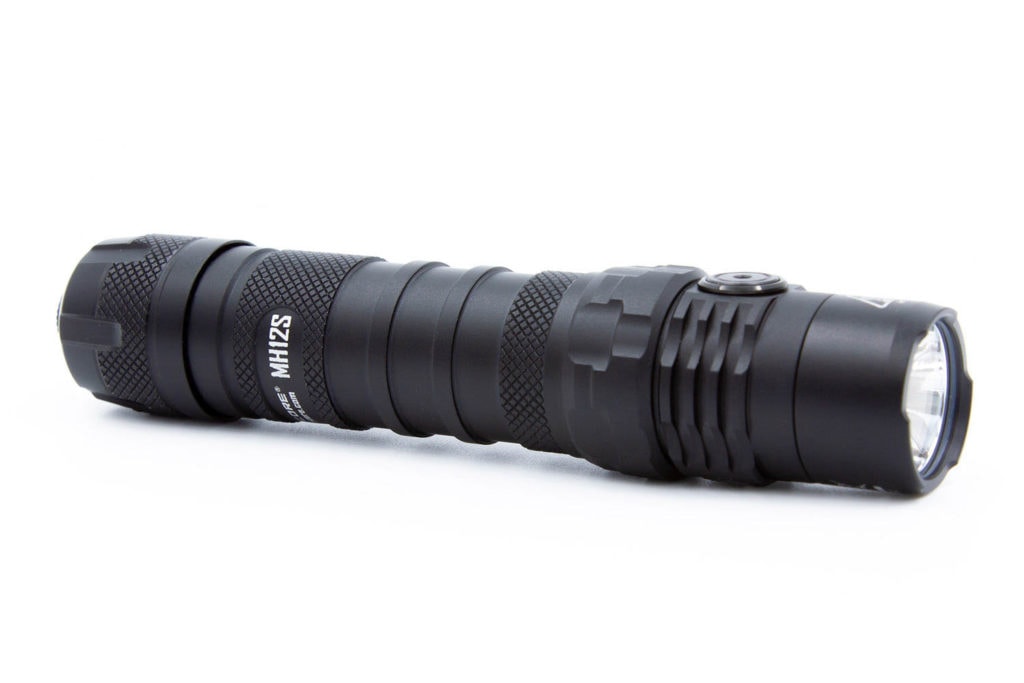
Specifications
| Brand/model | Nitecore MH12S |
|---|---|
| LED | Luminus SST40 6500K |
| Lumens | 1800 lm |
| Beam intensity | 21600 cd |
| Battery config. | 1*21700 / 1*18650 / 2*CR123 |
| Material | Aluminum |
| Modes | 5 |
| Blinkies | Strobe, SOS, Beacon |
| Reflector | Smooth |
| Waterproof | IP68 |
| Review date | December 2020 |
INTRODUCTION:
Today I’m taking a look at the Nitecore MH12S, which appears to be getting quite an amount of attention of late in the tactical flashlight space. This is the latest of the Multi-task Hybrid series, and comes with its own particular set of features.
My first thoughts were – throw a P20i, P10v2, and something like a Sofirn SP32A together, and out pops the MH12S. But it’s more subtle than that – this light is designed specifically for this configuration, and not just thrown together.
After reviewing the Nitecore P20i, I’ve been far happier with Nitecore’s releases – their new driver that eliminates PWM is a fantastic addition to the stable, and putting the SST40 into their lights has opened up a new level of output.
Let’s see how we get on!
Package quality.
As always – the Nitecore packaging is simply sublime. A solid retail box with all the features and information you could want, and a rundown of included accessories.
As with all Nitecore lights, this has everything you need to get up and running with the light. Additional accessories are available, but this is more than sufficient for a number of use-case scenarios.
The full list of items within is:
- The MH12S itself
- An NL2150 5000mAh 21700 cell inside (with battery isolator)
- Nitecore NTH10 holster
- Lanyard
- 2x o-rings
- Stainless clip with coating
- Battery magazine for 2x CR123 or 1x 18650
- Manual
- Warranty card
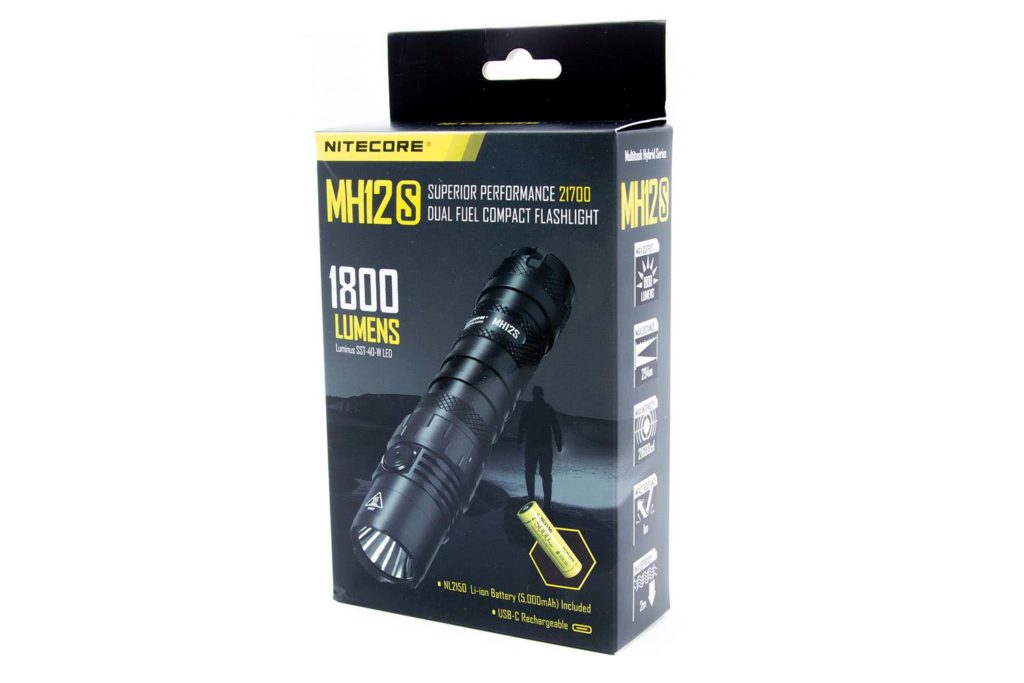
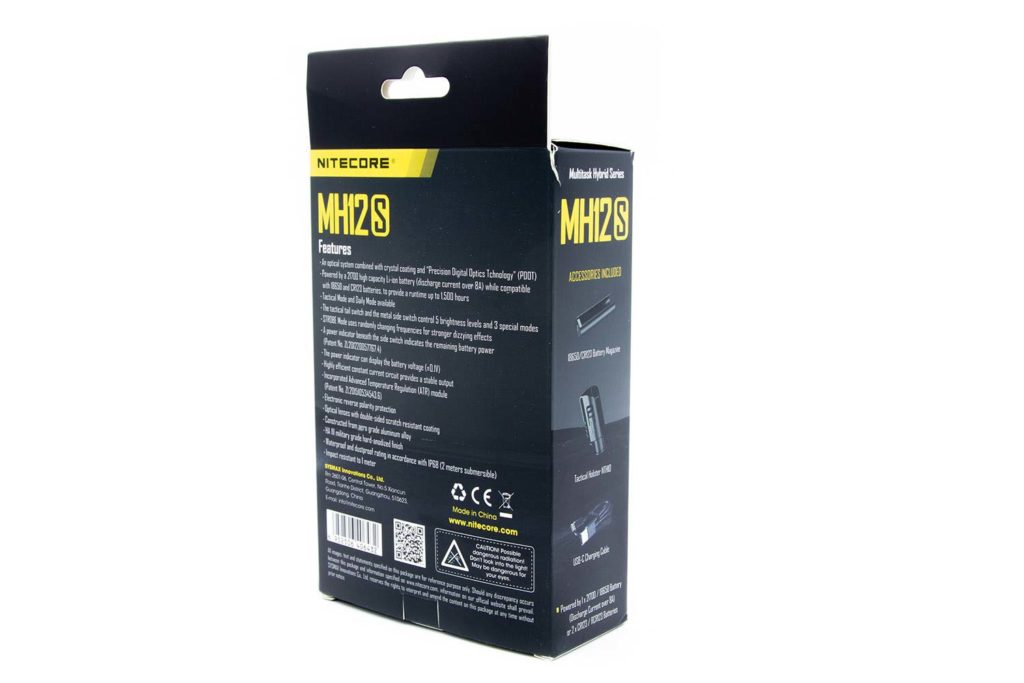
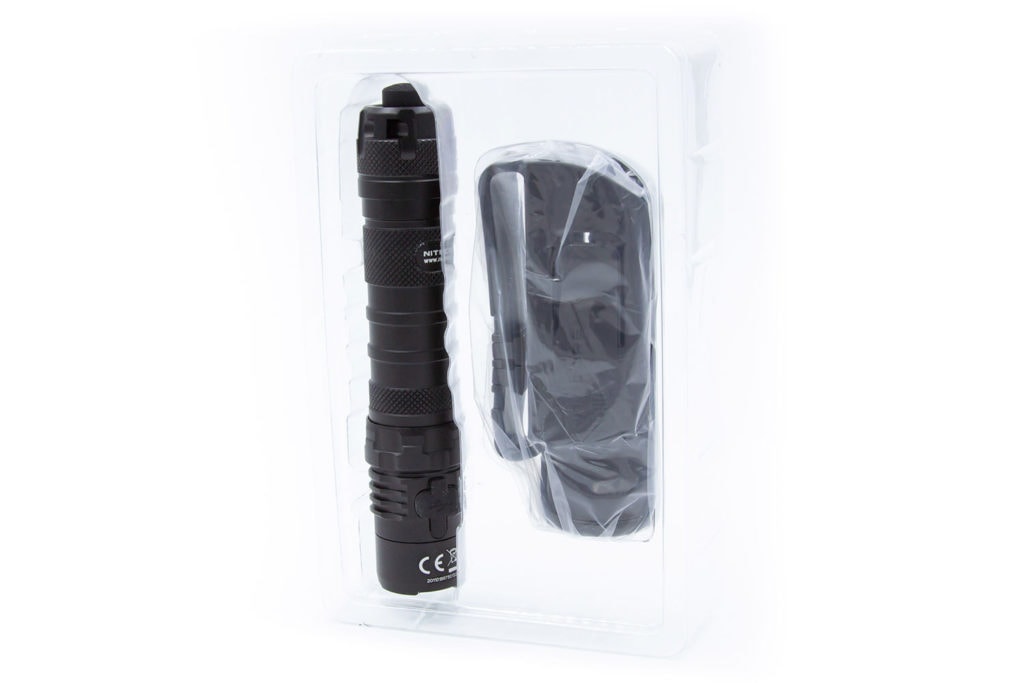
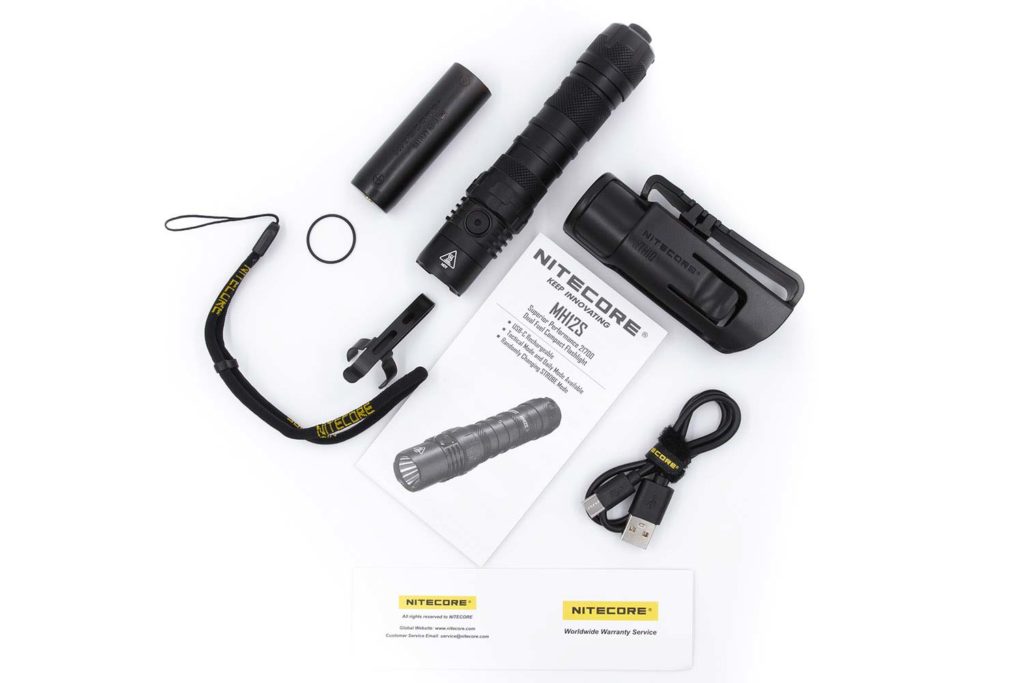
Handling of the FLASHLIGHT
As with other tactical Nitecore lights, the MH12S is designed from the ground up to fit snugly in your hand, giving a secure grip for whatever you encounter. It’s effectively a 1” diameter tactical light, with other sections a bit wider to provide a tactile indication of light orientation and placement.
There’s a rear tail switch with momentary-on, for quick illumination – this will always light up in your last-used mode (except strobe). The e-switch near the head rotates through modes while on, and is also used to enable strobe.
For a tactical light, I was at first confused as to how this would work – the mode switch button is somewhat distant from the activation switch, and when held overhand in the tactical position, I didn’t see how that would be possible. Impressions don’t matter though; results do – in actual use, my pinky sits on the mode switch while my thumb is on the rear switch, so it’s very possible to do what’s needed.
That said though, in most situations that this kind of light is needed, the rear switch is most likely all that’s needed for a simple on/off.
The wider section just behind the head of the light provides a modicum of anti-roll, but it’s best to keep a hold of it or lay it on something fairly level to prevent it from rolling off.
The holster included is the same as I’ve previously seen with the P10 v2 – while it’s suitable, it’s perhaps slightly too narrow, as this light is decently wider than the P10 v2, especially just behind the head. The holster bulges slightly when it’s fully engaged, but I don’t see it as causing any kind of long-term issues. The clip and lanyard are the same as in other Nitecore lights I’ve reviewed, but in this instance, there’s a lanyard hole in the tailcap to give another mounting option.
The light won’t tailstand due to the very proud tail switch, but that’s okay.
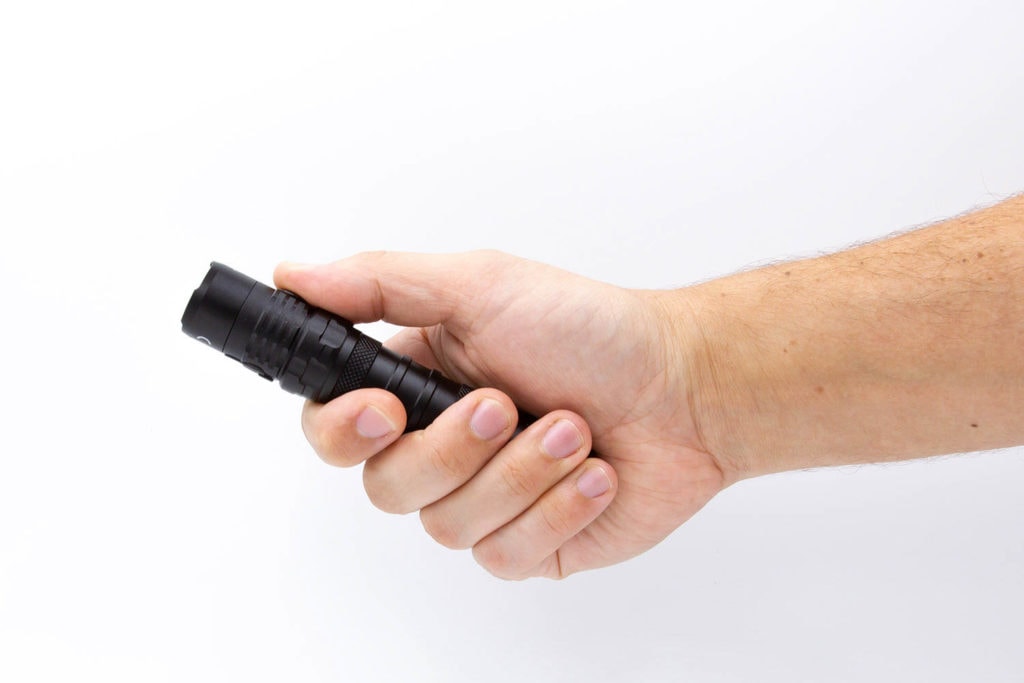
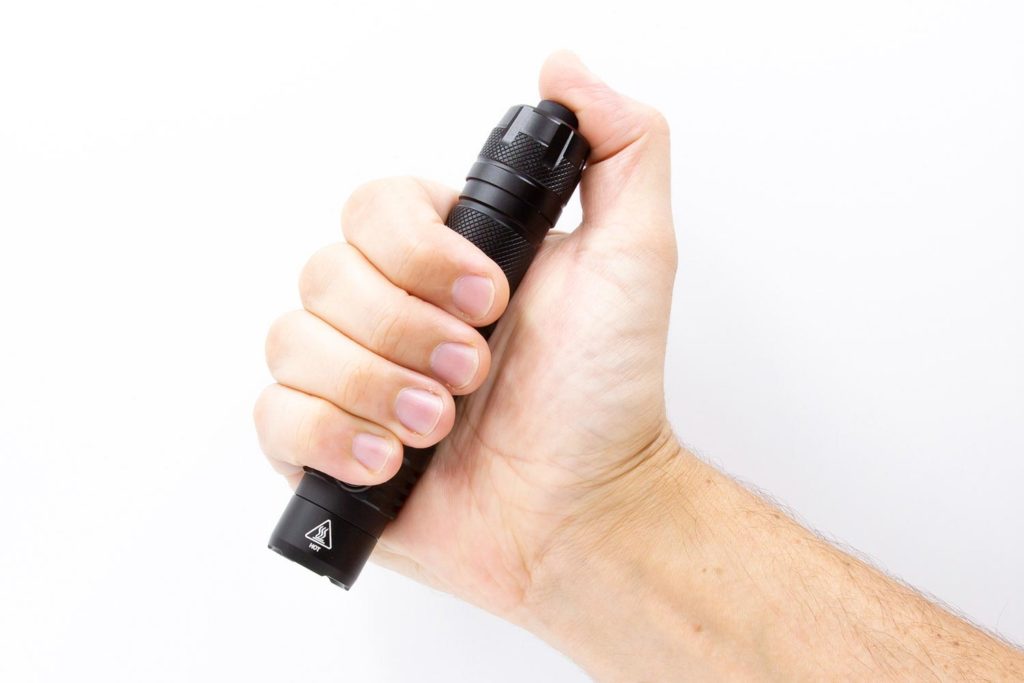
Build Quality, and Warranty
As always, the build quality and anodisation on this, or any Nitecore light, is top notch. There’s one small exception, but I’ll get to that below.
There’s knurling at multiple points on the light – just behind the widened section behind the head, most of the way down the body tube, and on the tailcap. It’s fairly smooth, but still provides a small amount of grip, but the rest of the design of the light will provide good grip. Again, there’s the trenches for the clip/tactical ring/etc attachments, and these appear to hold onto my hand quite well when trying to slide it through while holding it.
The knurling on the tailcap appears somewhat superfluous on the tailcap though, because there’s decent cutouts on it that give far more grip – but I concede that it’d look quite odd without it.
The threads are very smooth, and decently lubricated. No complaints there at all.
As mentioned above, there’s a small exception with the knurling. There’s one small marking on the light that I received, which is very out of character for Nitecore. On the knurling just below the head, I have a small patch that initially looked like a piece of pastry or similar had fallen in the grooves of the knurling, because I do like my donuts and that makes it a distinct possibility, but I haven’t been able to get it out. It may be a small miss in the anodisation, but it’s very hard to tell.
As mentioned though, that’s very unusual to see on a Nitecore light, so I’m going to chalk it up to something slipping through the cracks as a once-off, as every other MH12S I’ve seen reviews of looks perfect.
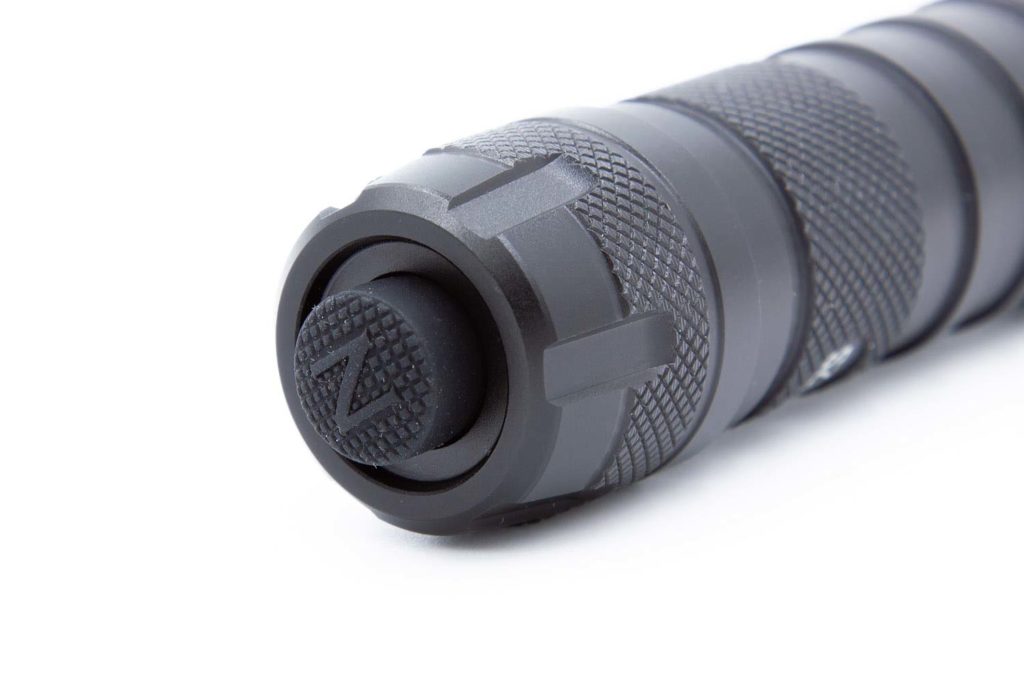
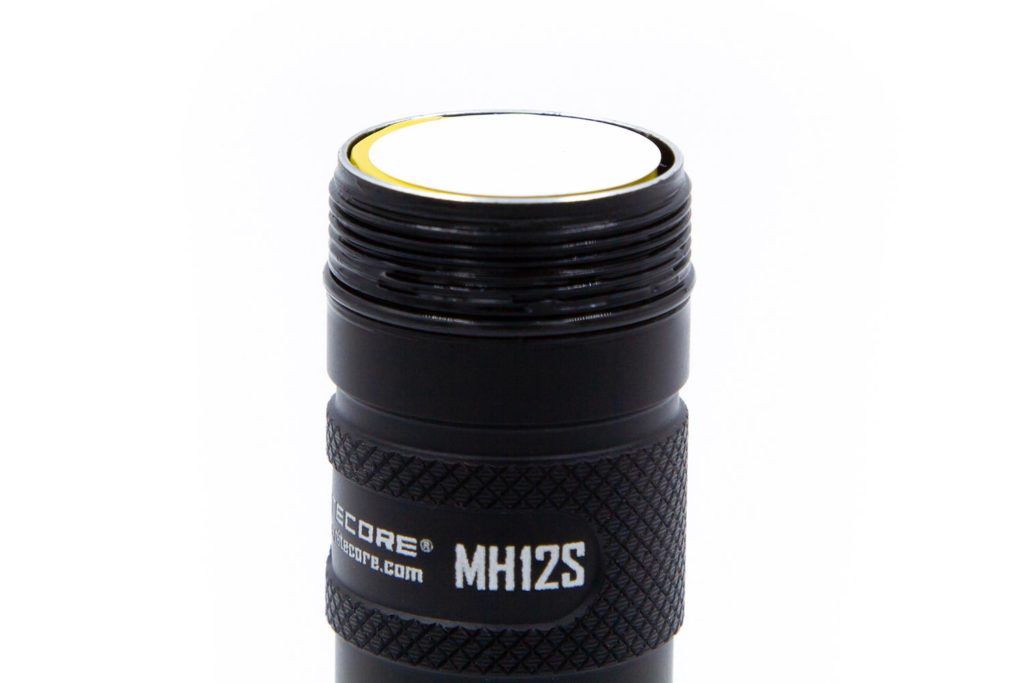
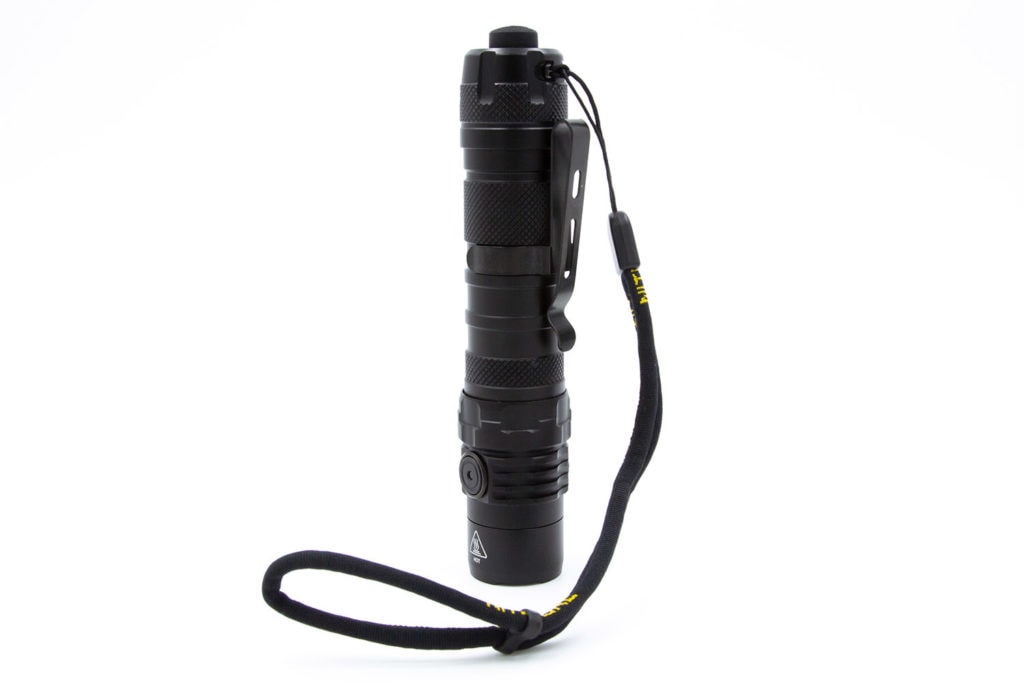
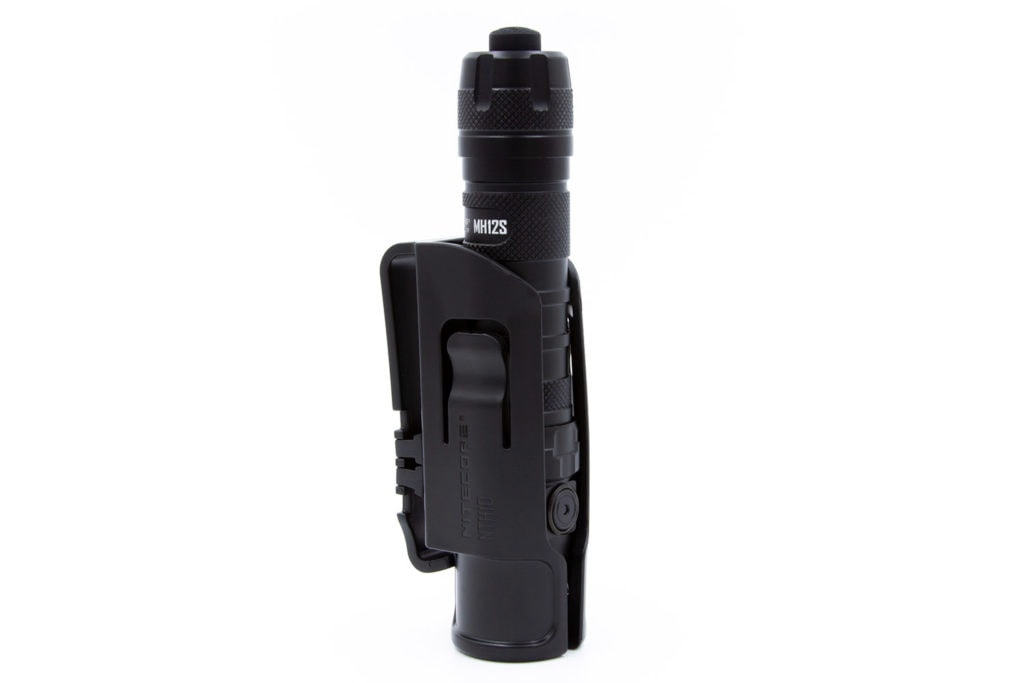
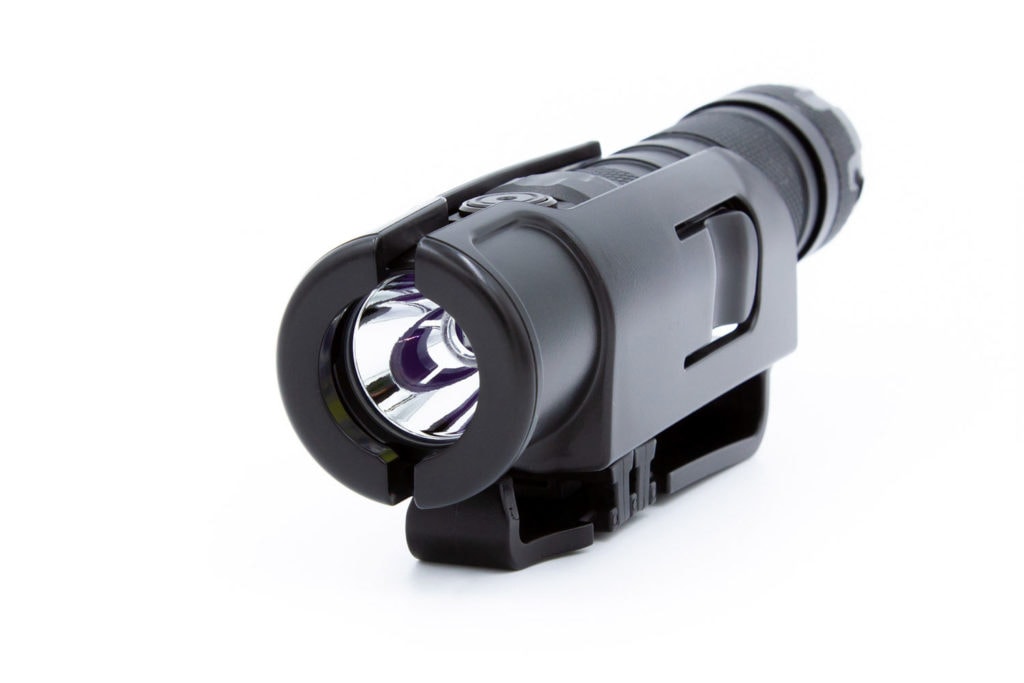
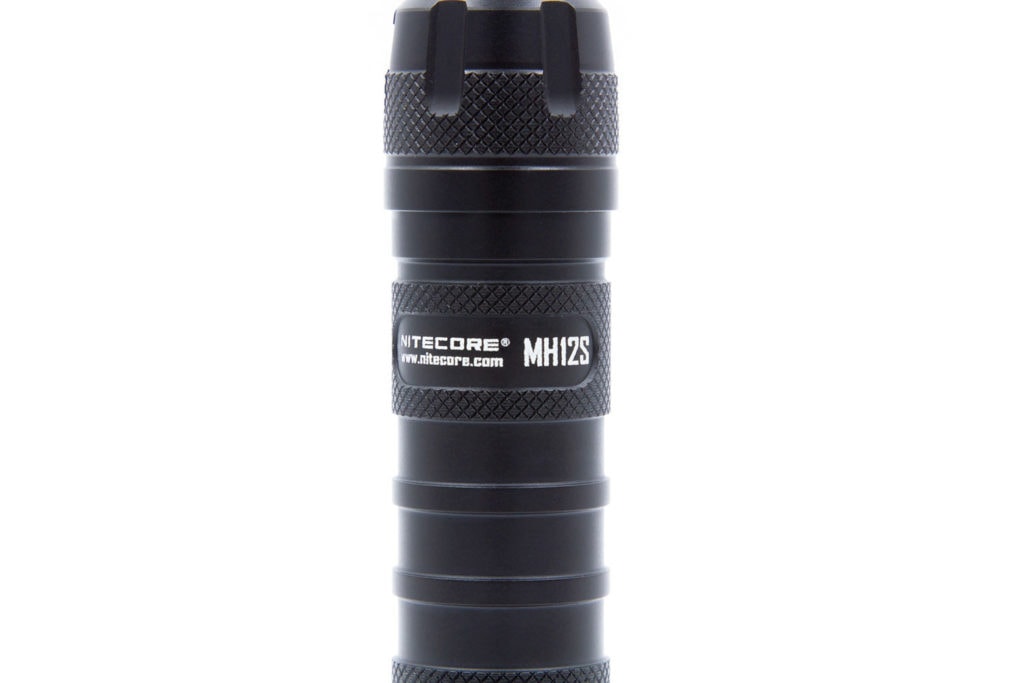
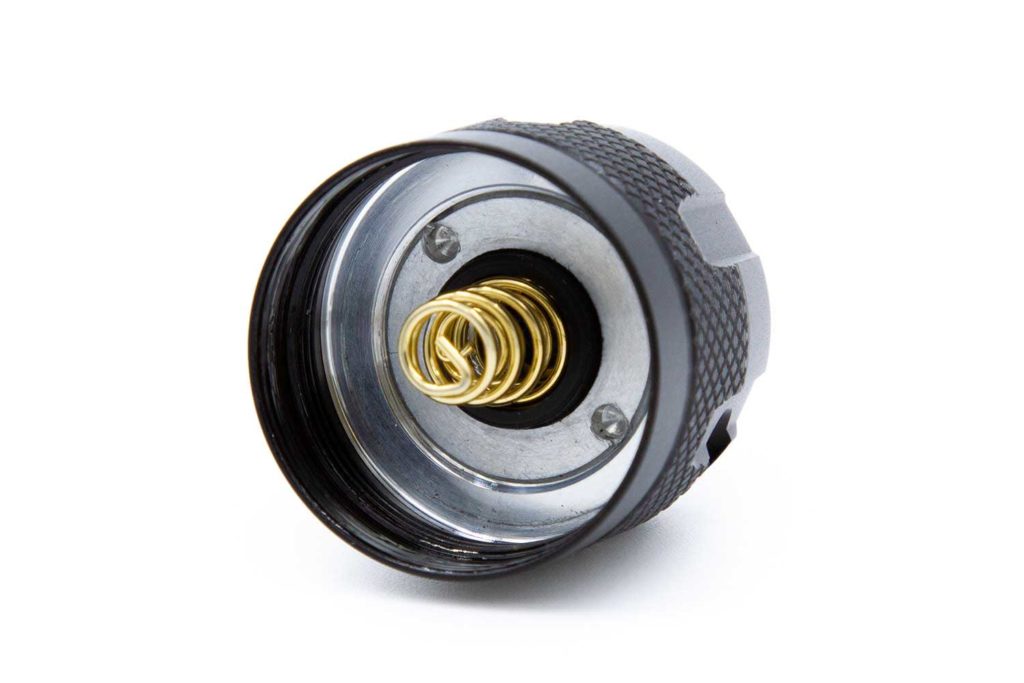
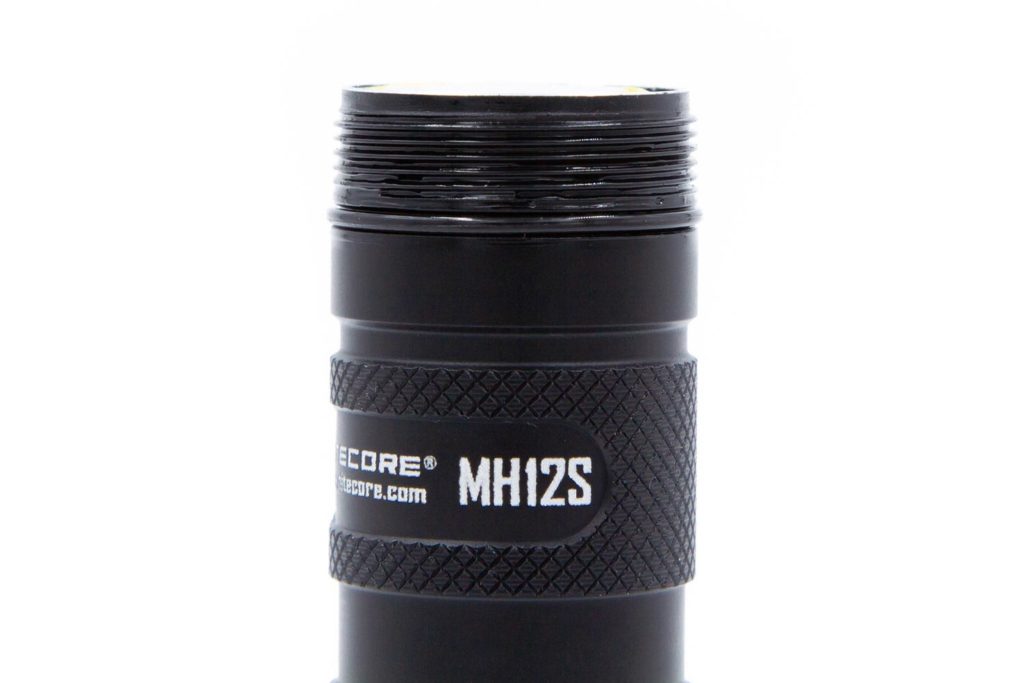
LED, LENS, BEZEL, AND REFLECTOR
The MH12S uses an SST40 emitter at 6500K, which is, as always, the go-to colour temperature for tactical lights. Moving to the SST40 from the Cree XPL previously used is a fairly new change, and was seen with the P20i, but it’s good to see it continue.
The move to the 5050 emitter format gives more possibility for higher lumen outputs. The SST40 is probably the best 3V 5050 emitter at the moment when taking tint shift, output, and beam angle into consideration. I’d personally love to see it available in warmer temperatures and/or higher CRI, but that’s up to Luminus.
There’s a very lightly crenulated bezel at the head, so very much not an attack bezel; below that is a smooth reflector and then the emitter itself. I’m curious as to how much wider the hotspot would be with an OP reflector, but the smooth reflector is still well suited.
There’s a bright hotspot which fades quickly into the corona and then the spill, which is to be expected. Business as usual here, with the edges of the spill having a brief “shadow” due to the light crenulation.
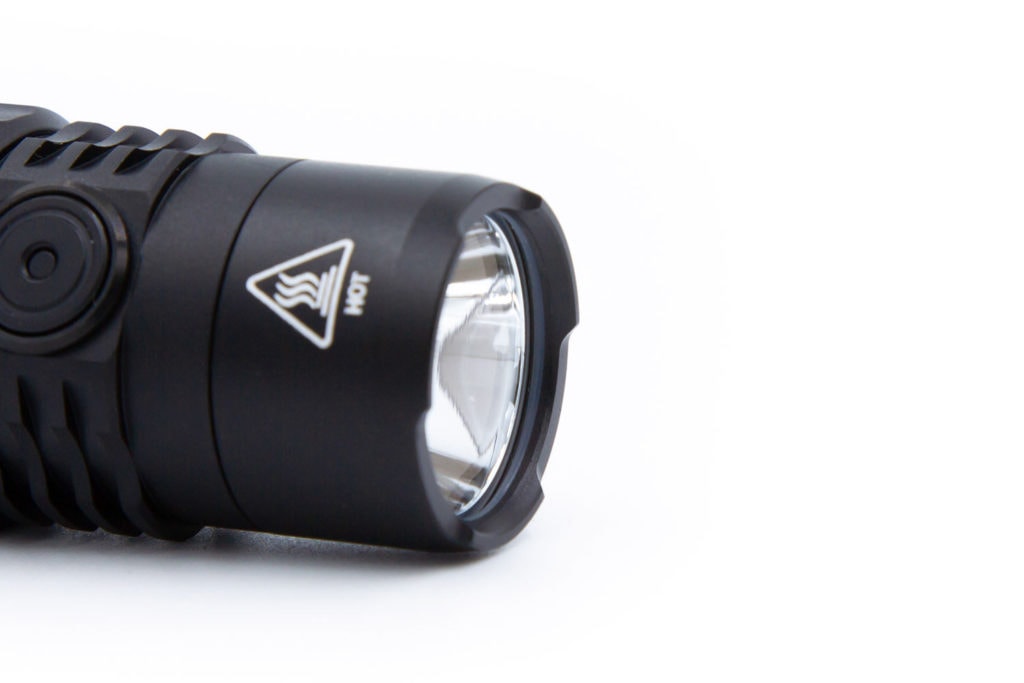
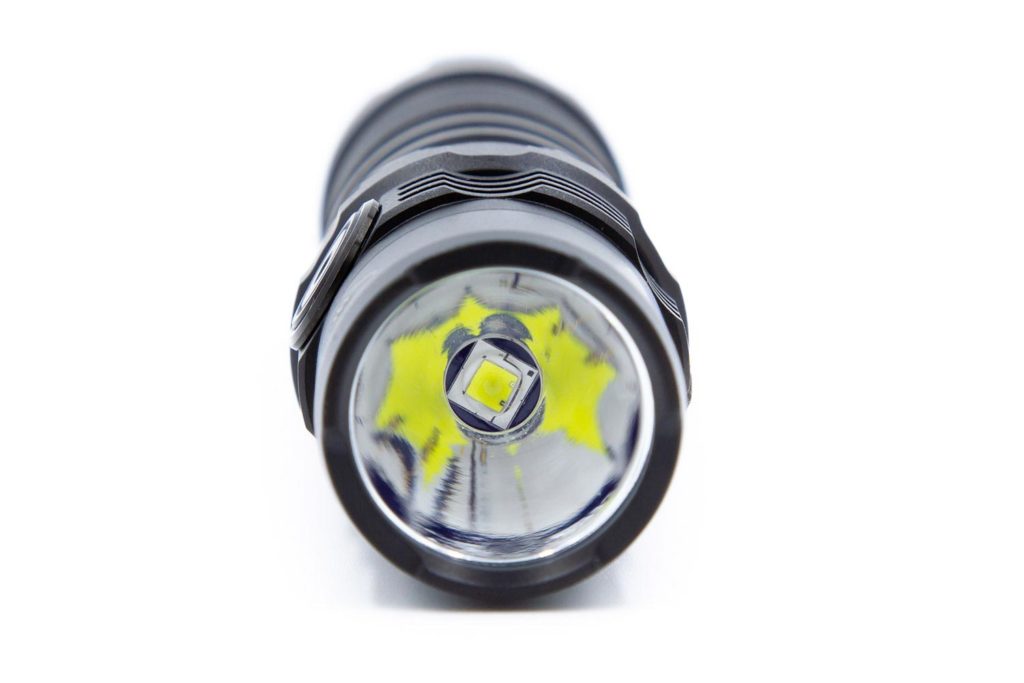
Dimensions
- Length: 135.7mm (5.43”)
- Bezel diameter: 25.4mm (1”)
- Widest part of head diameter: 29.5mm (1.16”)
- Body diameter: 24mm (0.94”)
Weight:
- Empty: 74.1g (2.61 oz)
- With included NL2150: 146.7g (5.17 oz)
Nitecore Tactical Flashlights Comparison
The Nitecore MH12S compared to other Nitecore tactical flashlights.
Image 1: from left to right: Nitecore P20i, Nitecore MH12S, Nitecore P10 v2, Nitecore P20 v2.
Image 2: from left to right: Convoy S2+, Nitecore MH12S.
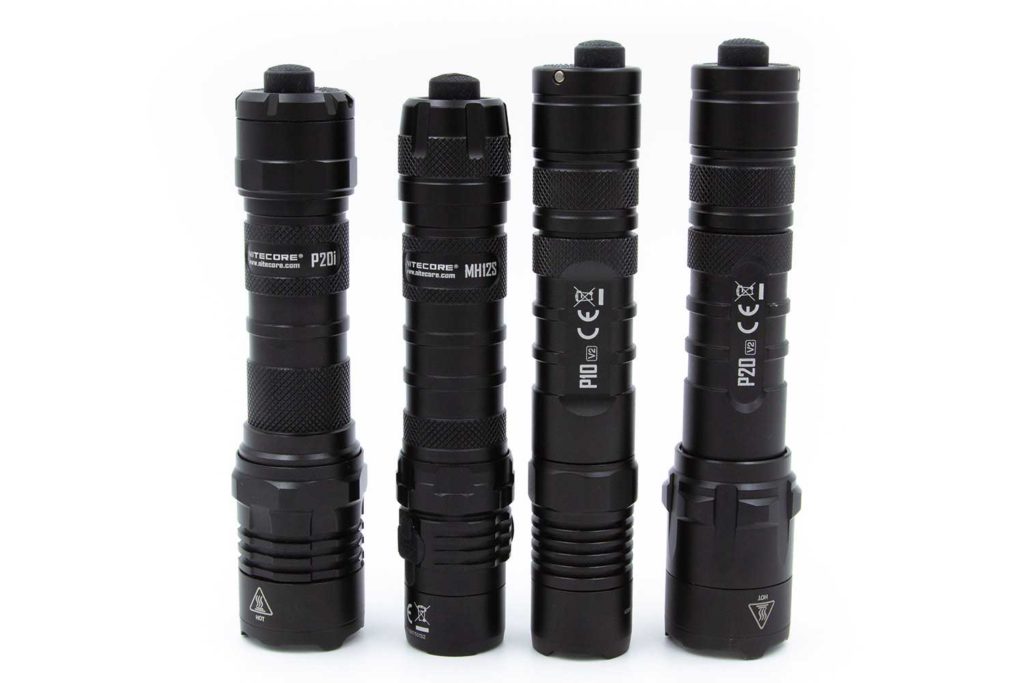
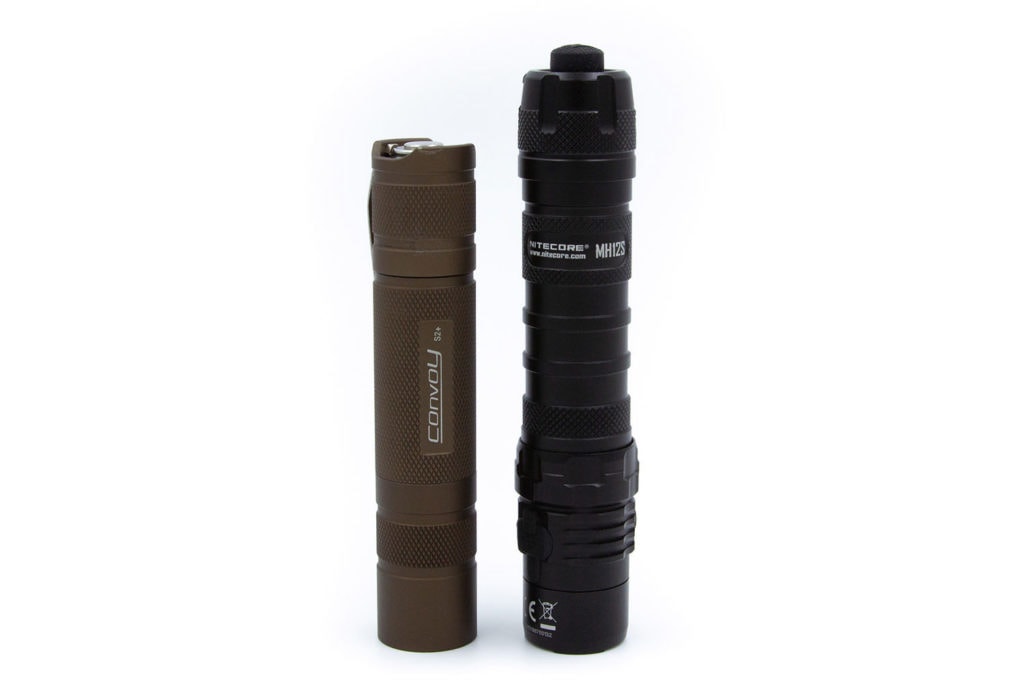
Driver & User Interface:
As with a lot of Nitecore lights, there’s multiple overarching “modes”, with slightly different configurations. In the MH12S, they’re Daily and Tactical modes. There’s five modes in total – Ultra-low, Low, Medium, High, and Turbo.
Daily mode starts in Ultra-Low and cycles upwards to Turbo, whereas Tactical mode cycles the other way (Turbo down to Ultra-Low).
To change between Daily and Tactical modes, hold the mode switch while the light is off, and then press the tail switch. Keep holding the mode switch for around 5 seconds, at which point the blue power indicator on the mode switch will flash rapidly. The indicator will indicate a user mode by flashing once for Daily, and twice for Tactical.
The irony in this, of course, is that your thumb will most likely be occluding the indicator LED while it’s flashing rapidly.
Rear switch:
From OFF:
- Fully click: On
- Half-press: Momentary on (Memory mode when in Daily mode – Turbo in Tactical mode)
From ON:
- Fully click: Off
Side switch:
From ON:
- One-click: Change modes upwards/downwards (dependent on Daily/Tactical mode)
- Hold: Activates and cycles strobe modes:
- Daily mode: Strobe – Beacon – SOS. Release the side button to choose your desired strobe. Press the side switch again to return to the last-used mode.
- Tactical mode: Strobe only. Press the side switch again to return to the last-used mode.
Mode memory:
- Both Daily and Tactical modes remember what you were using last, but the momentary mode when half-pressing the tail switch will only remember the last in Daily mode.
Low voltage warning:
- When the battery is 50% depleted, the power indicator on the mode switch will flash every two seconds. When the battery is close to being drained, it will flash much more rapidly.
Strobe/blinkies
- You can access Strobe in both Daily and Tactical modes, and Beacon or SOS in Daily mode. This is done by holding the mode switch while the light is on.
Lock-out mode:
- You can lock the light out by twisting the tailcap ¼ turn; there’s no software lockout.
PWM
- As per the P20i, there’s no PWM on this light. Just lovely.
Batteries & Charging
The MH12S is able to use both the 21700 cell included, as well as providing a carrier to run 2* CR123 cells in parallel, or an 18650.
There’s a USB-C port on the side near the head, and you can recharge the 21700 or 18650 in the carrier with that; it works on both USB-A to C and USB-C to C, which is always good to see.
That said, don’t try and recharge CR123 cells! Bad Things™ will most likely happen.
Because the MH12S doesn’t use a proprietary cell, you can use most 21700s in this. I’ve tested with a Samsung 30T (unprotected), as well as an Imalent MRB-217P40S from the MS06 review, and both work and charge fine. That said, my 30T is slightly narrower than the included cell, so it rattles slightly more.
I put the light on charge after removing it from the box and taking initial photos, and it was charging happily away at between 1.9A to 2A – I expect the battery to be at around 50% charge out of the box, so this is what I would consider the peak charge rate. The current will lower as the cell approaches full, but I’m happy to see 2A out of an internal charge.
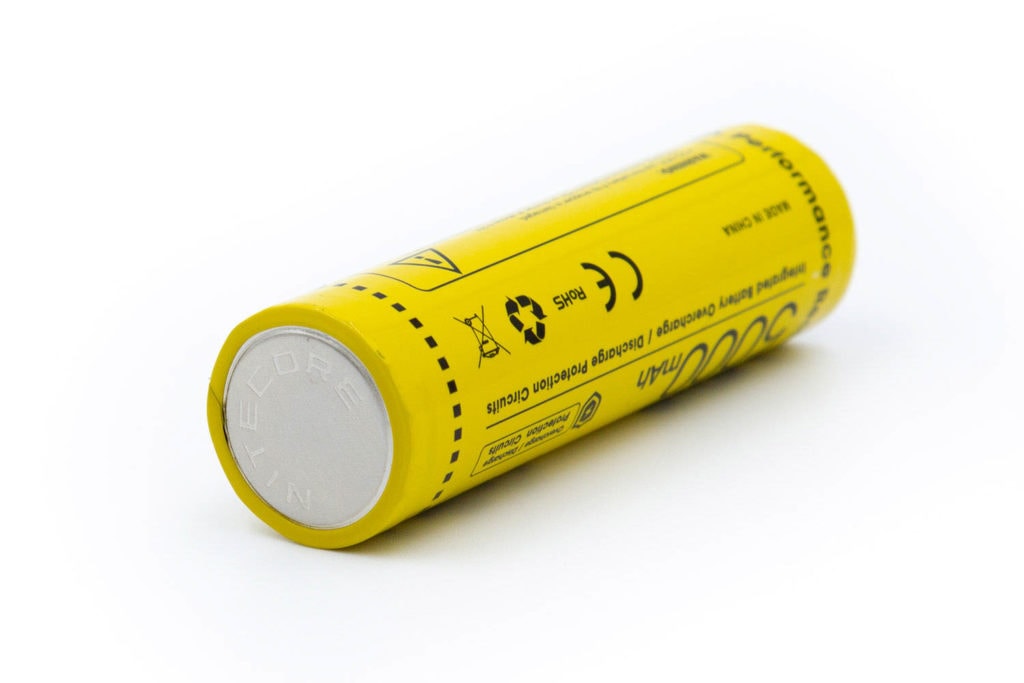
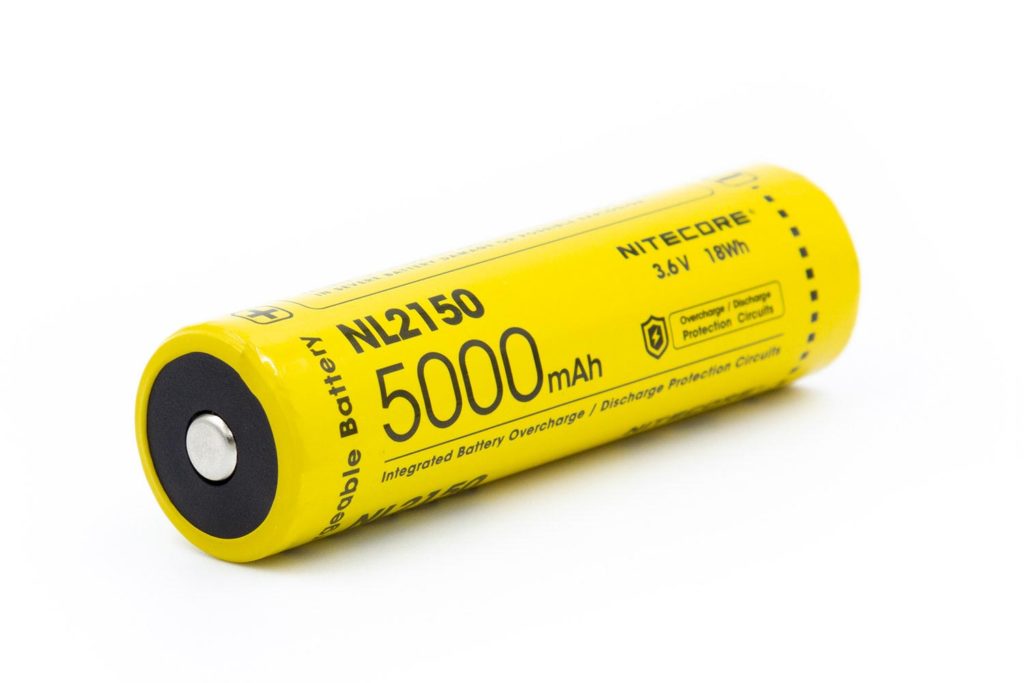
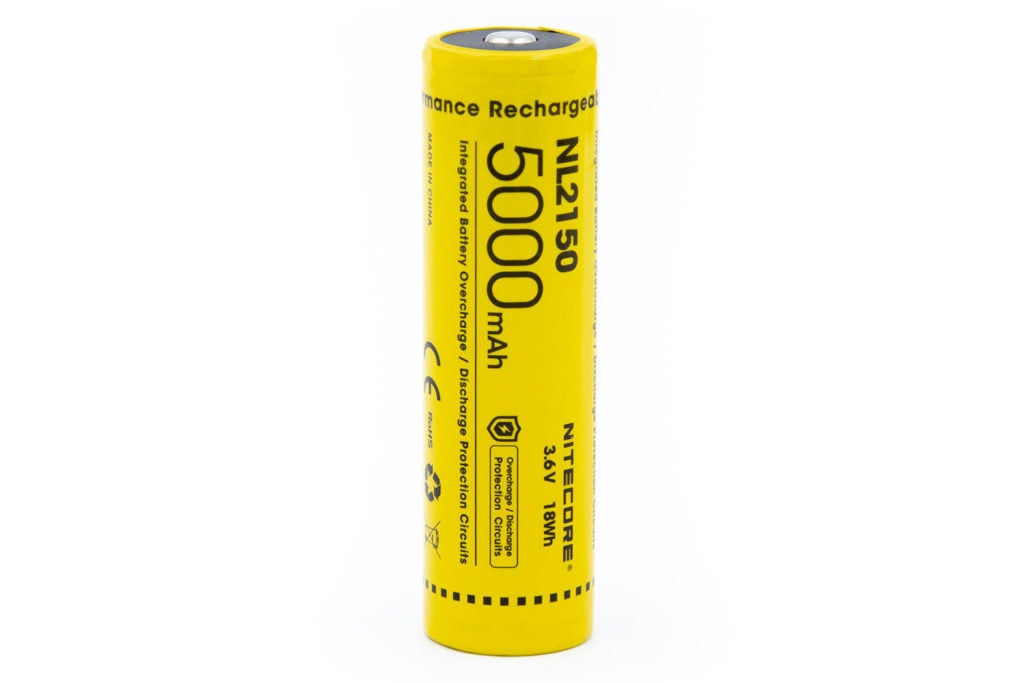
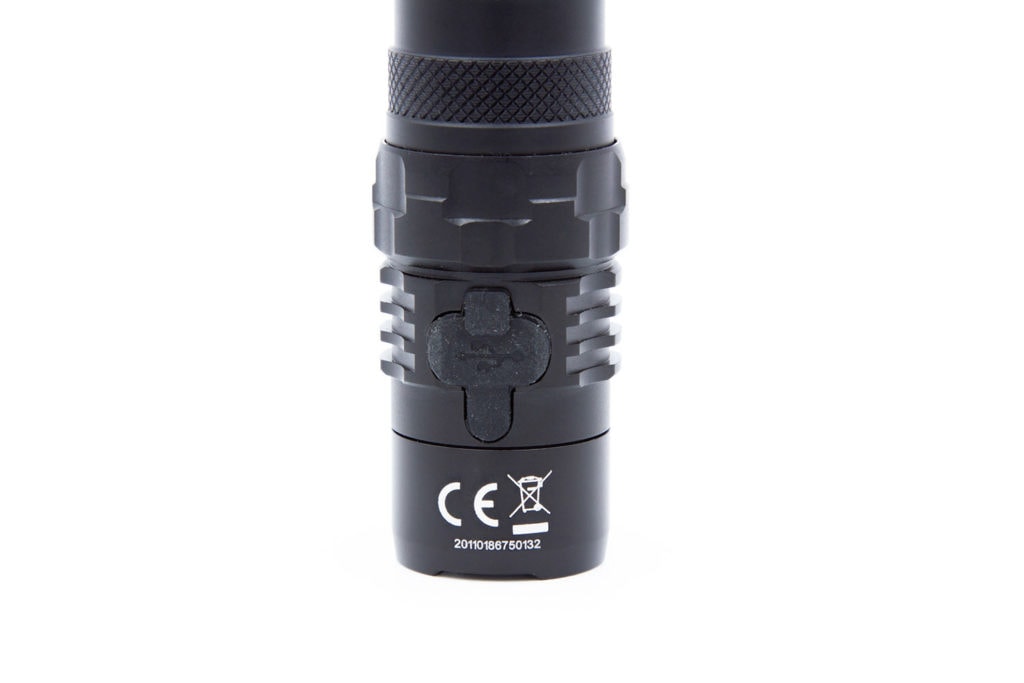
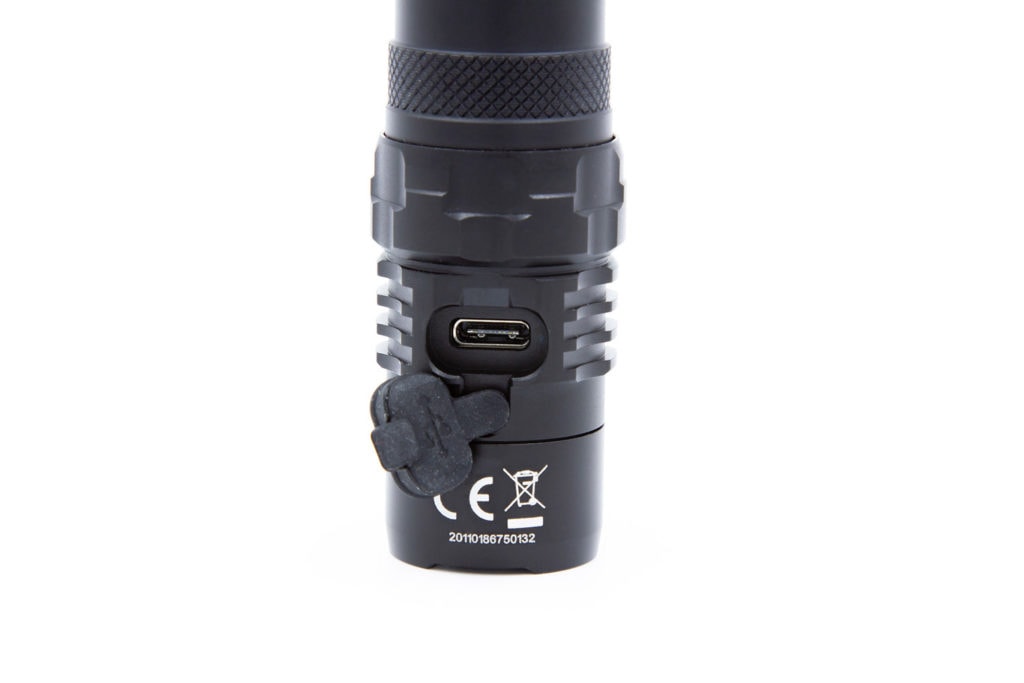
Performance
For my readings, I use the following:
Lux Meter: For lumen readings and runtimes, an Adafruit TSL2591 connected to a Raspberry Pi running Ubuntu, using RuTiTe by bmengineer in a custom sphere (build document coming soon, when I have some more time). A UNI-T UT383S is used for candela readings. An Adafruit MCP9808 rounds out the list for temperature monitoring.
DMM: UNI-T UT139C and UNI-T UT210E – 16AWG wire is used directly into the 139C via some banana plugs, and 8AWG wire in a loop for the UNI-T. The DMM I use depends on how high the expected current will be – I use the 139C for <10A, and the 210E for >10A.
I’ve tested output with the included Nitecore NL2150.
Amp measurement
- Ultra-low: See note below.
- Low: 80mA
- Med: 0.49A
- High: 1.85A
- Turbo: 6.1A
Ultra-low is an odd one – when measuring the current, I would get 9mA for two seconds when connecting the probes, then it would drop down to 3.6mA, and then every two seconds, quickly pulse back up to around 7mA, then back to the 3.6mA in a repeating cycle. I don’t fully understand this, so I’m going to put a line somewhere in the middle of it all and say 4.2mA, purely because of the constant cycle. I’d love to be able to do a graph over time of this, but I don’t have a sufficiently smart DMM (yet).
Runtime graph
Some preamble first:
I’ve chosen to do a runtime graph showing Turbo, High, and Medium. I’ve elected to skip Low, as I don’t think it’s a mode that it would be used in too much; Medium is probably the lowest long-use mode. I’m also skipping Ultra-low as it’s rated to run at 1 lumen for 1500 hours, and I don’t have a spare two months on the integrating sphere to spare.
That said – mathematically, I would need Ultra-low to be holding a constant 3.3mA to last 1500 hours, and as we’ve measured above, it’s a little above that. That’s getting into nitpicking territory, though.
I tested the battery after all runs went to shut-off, and the cell measured just under 3V, which is perfectly safe for the battery.
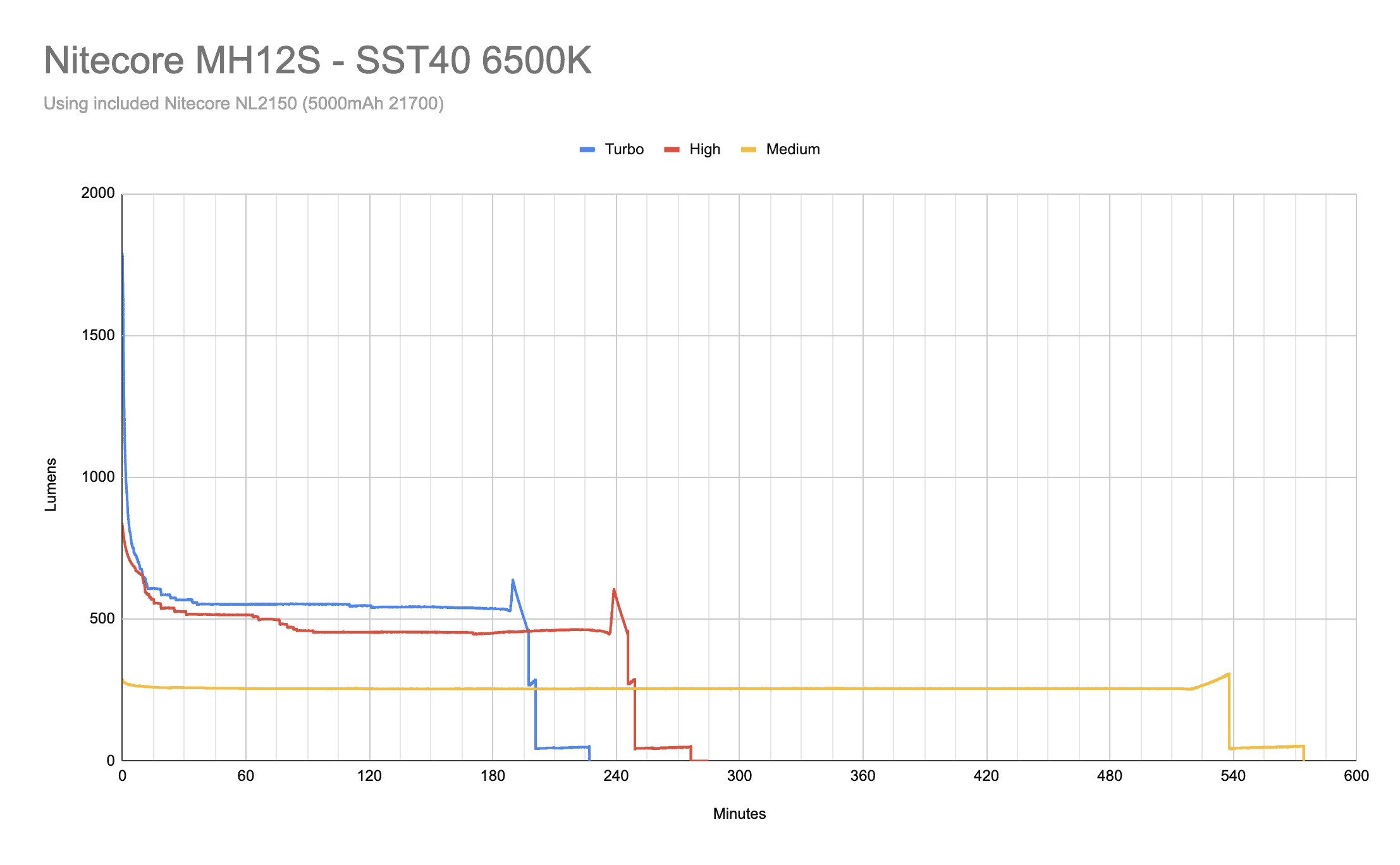
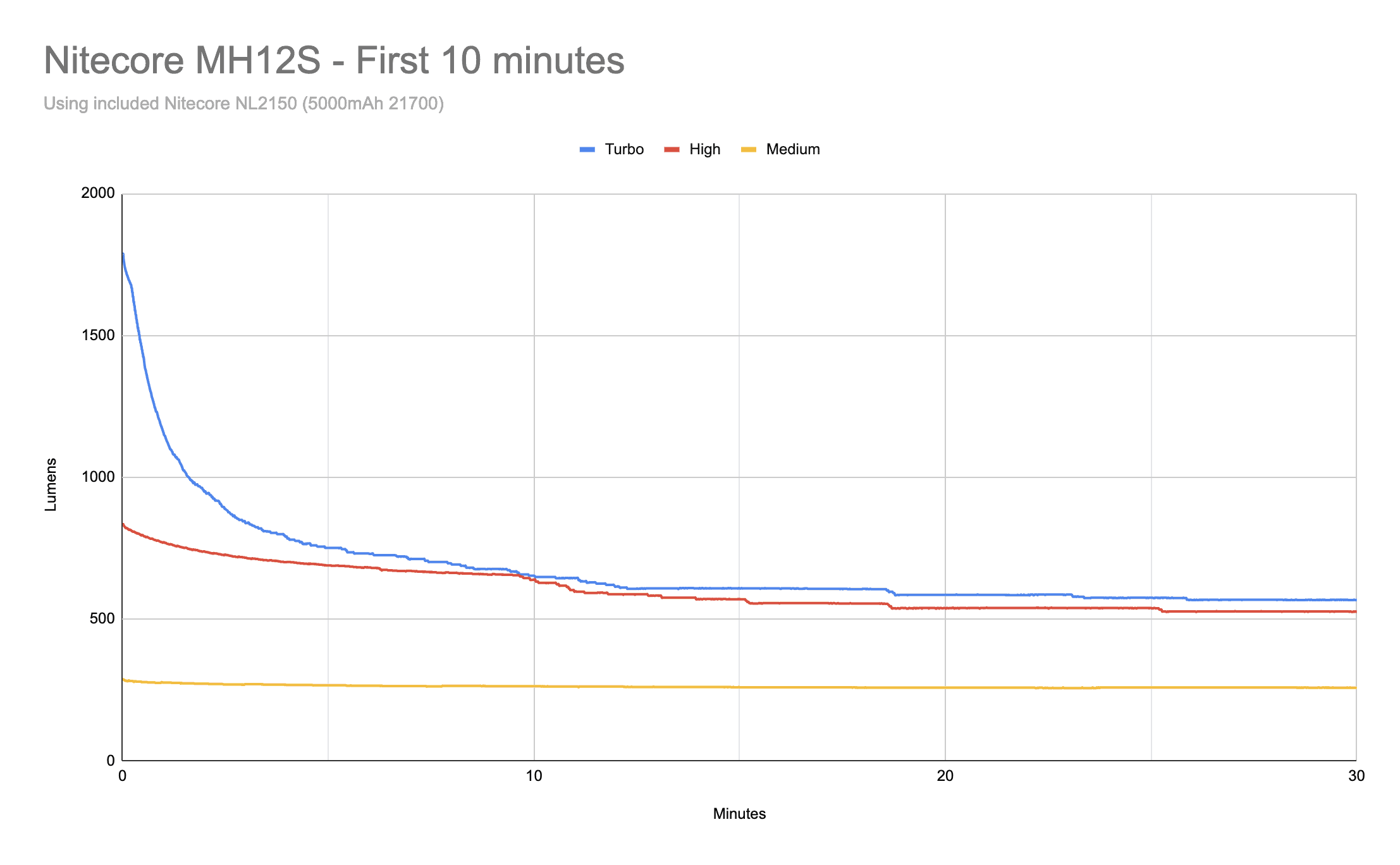
As expected, Turbo drops off quite rapidly due to the light not having a large amount of thermal mass, but for brief bursts in momentary mode, it’s definitely sufficient. Turbo and High have a similar runtime profile, with High coasting along at a bit lower output, and running for longer as a result.
Medium grabs onto around 260 lumens, and then holds that for over 8 hours, before flicking up in brightness a bit before dropping into low voltage protection. Not bad at all.
Lumen measurements (for each mode)
- Ultra-low: 2 lm
- Low: 45 lm
- Medium: 269 lm
- High: 916 lm
- Turbo: 1770 lm
A slight drop from expected at High, but the rest are well within the margin of error. Ultra-low may be a quirk of my testing setup, as it was flapping between 1 and 2 lumens, but more towards two – it’s possible there’s a tiny amount of ambient light getting in (time to bust out the paint again).
Throw numbers:
- 5m indoors: 1223 lux = 30,575 cd = 349.71 m throw
- 10m outdoors: 304 lux = 30,400 cd = 348.71 m throw
I recently got a laser measuring pointer, so I’m able to get my 5 and 10m distances even more accurate!
Beamshots
All beamshots at 0.3 sec, f8, ISO100, 5000K WB. Lights are approx 60cm from wall.
- Nitecore MH12S vs Nitecore P10 v2
- Nitecore MH12S vs Nitecore P20i
- Nitecore MH12S vs Nitecore P20 v2
- Ultra-low, Low, Medium, High, Turbo
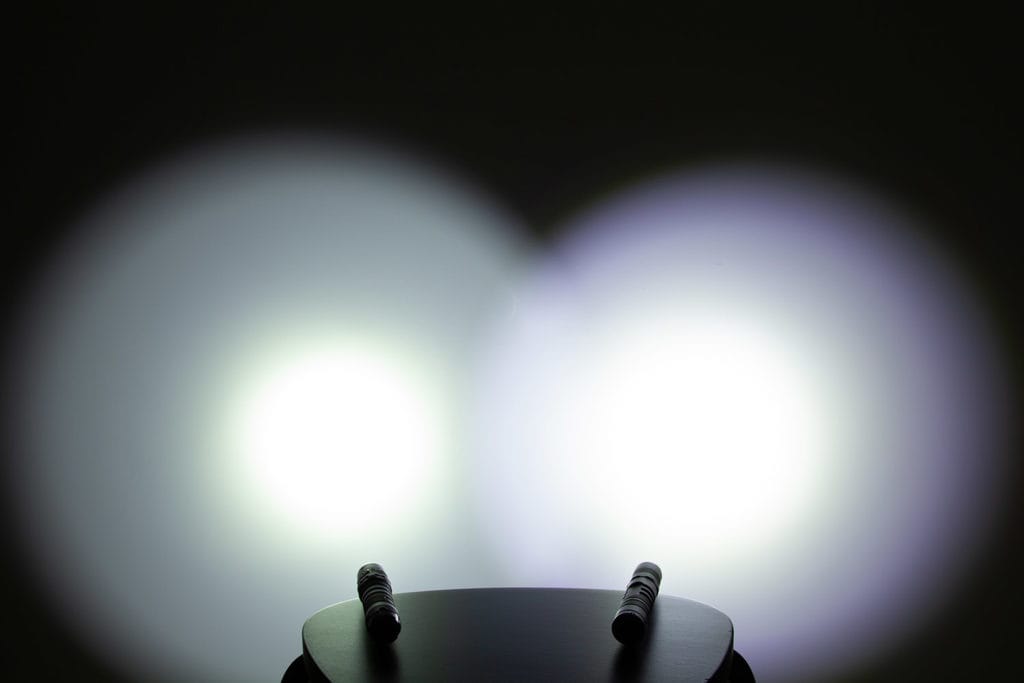
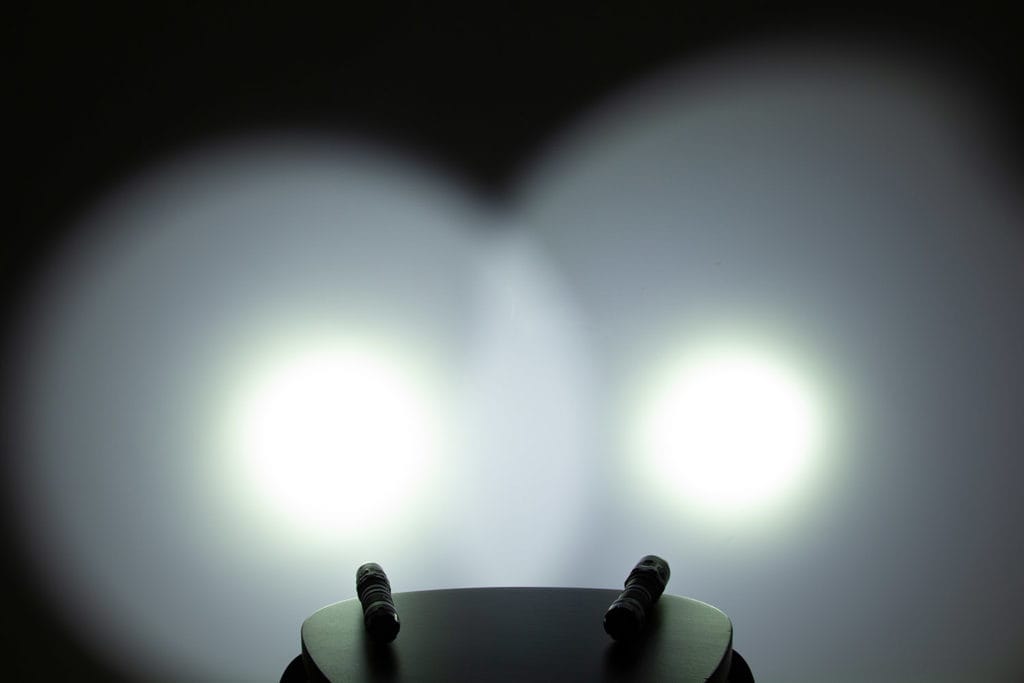
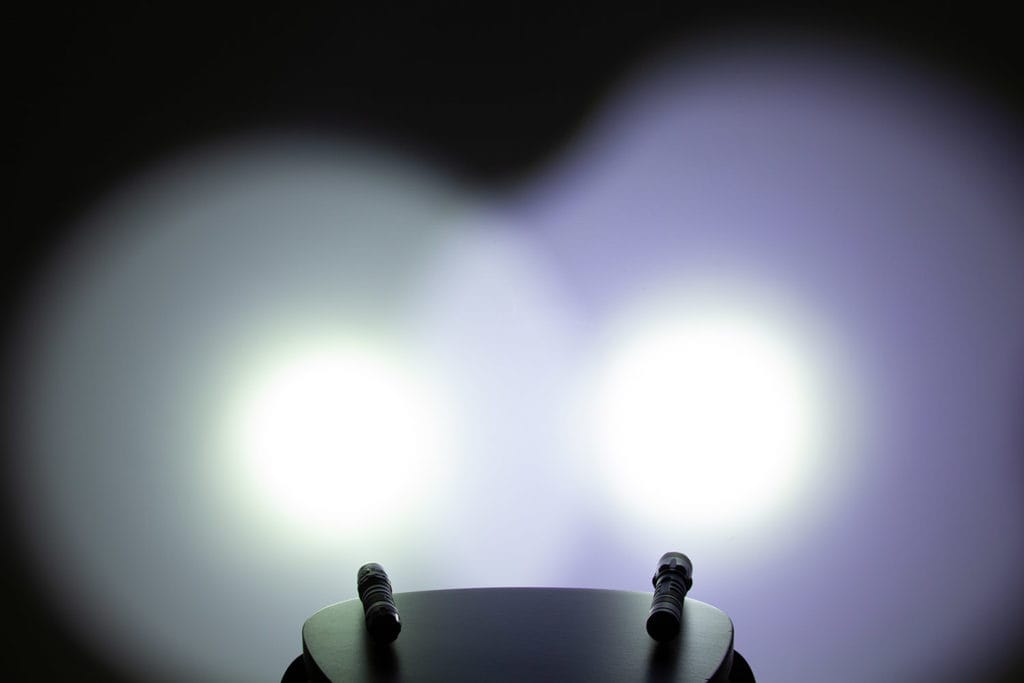
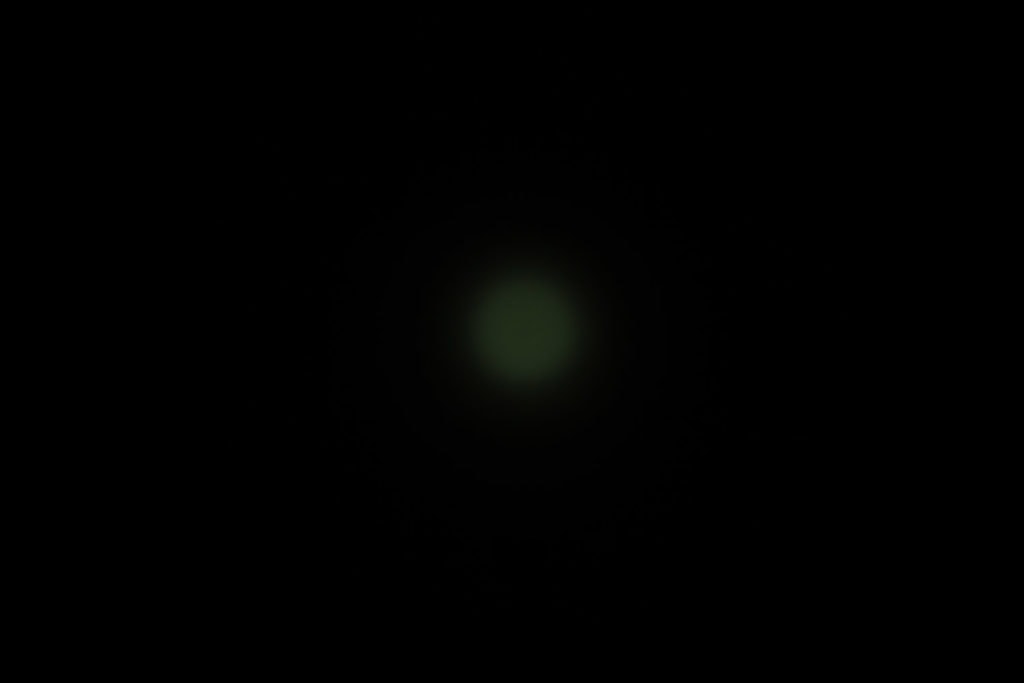
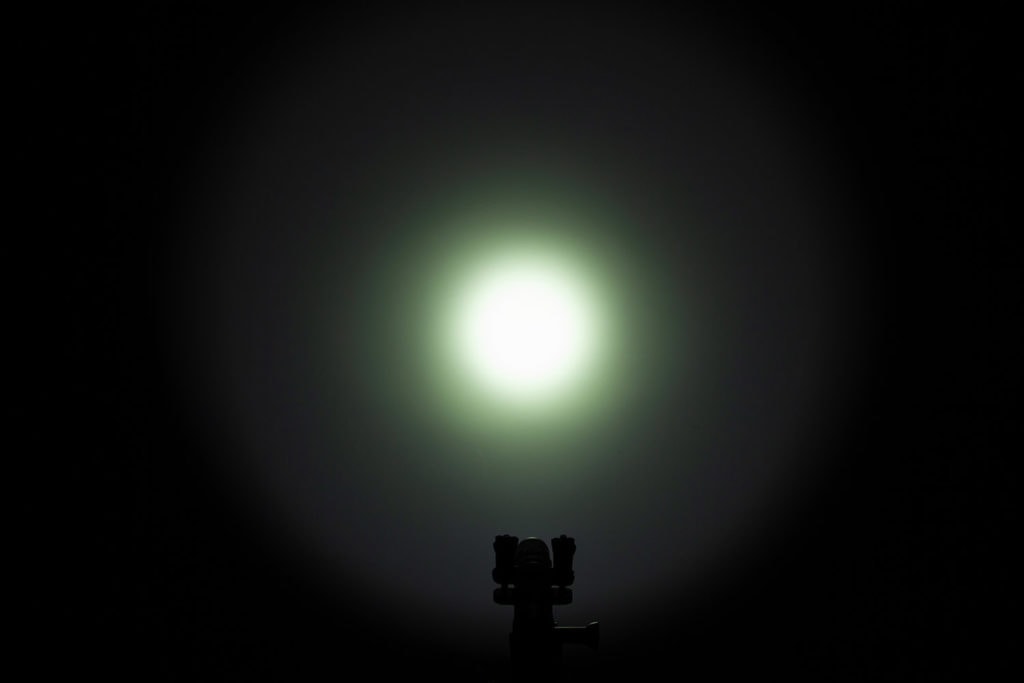
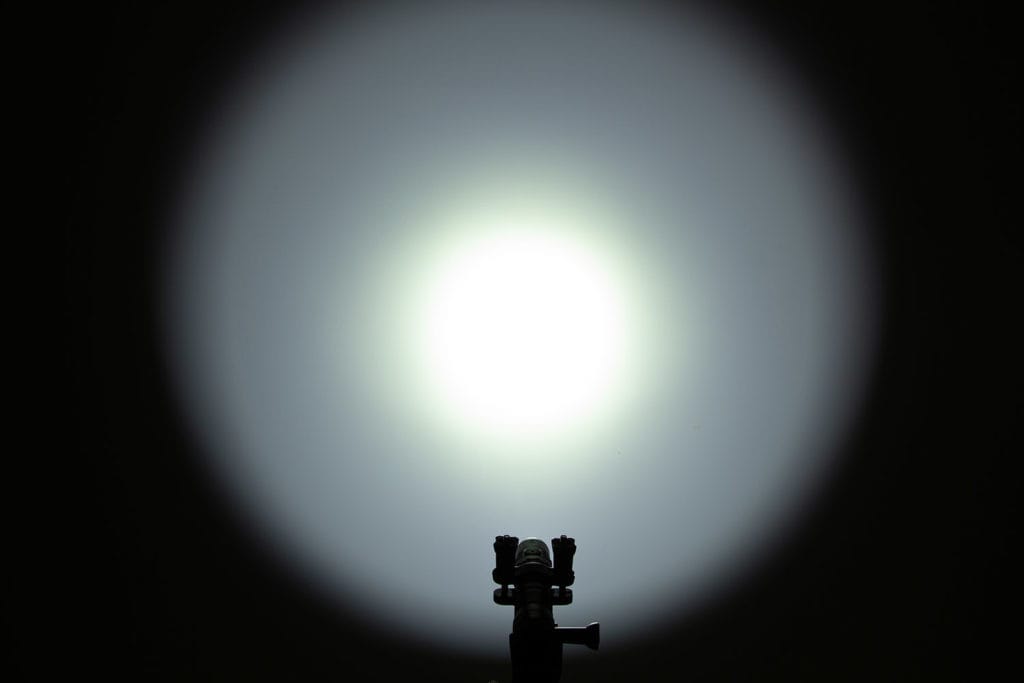
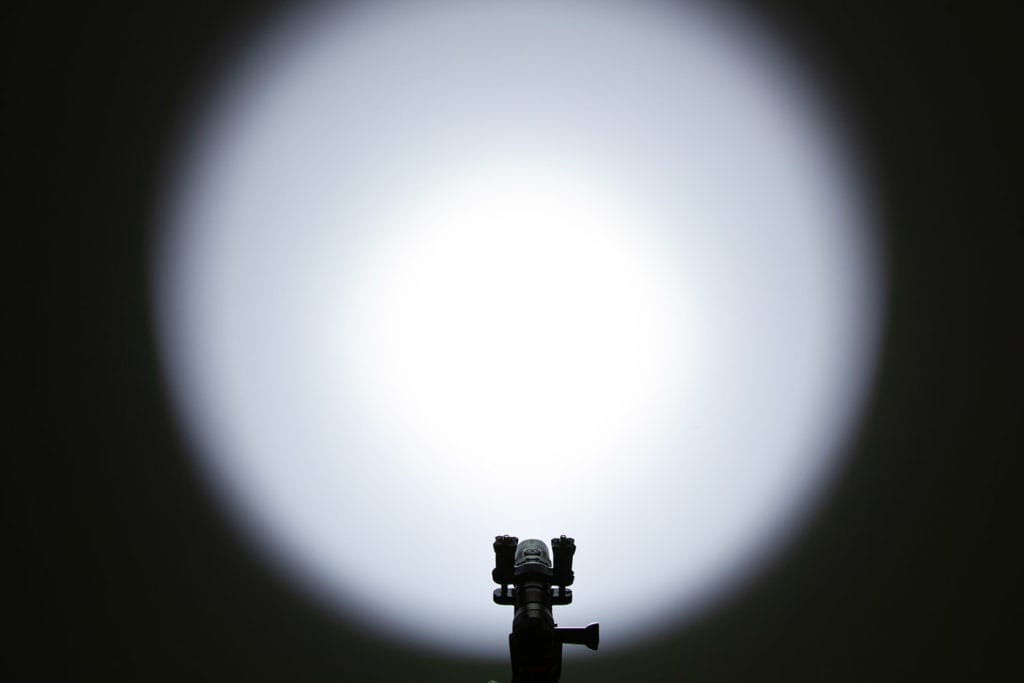
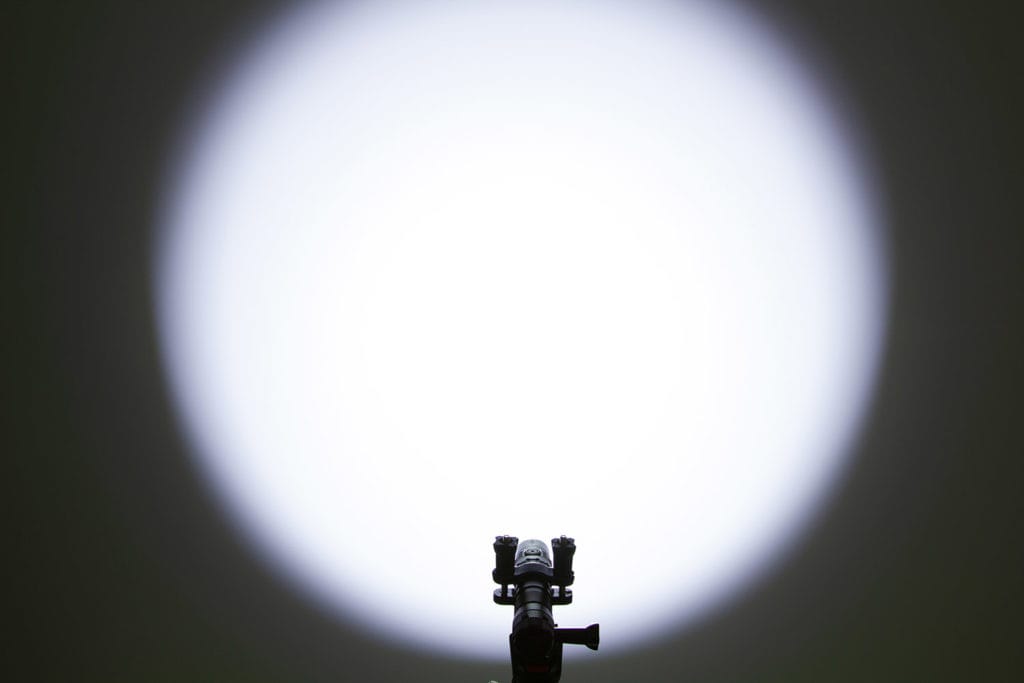
Disclaimer: This flashlight was sent to me for review at no cost by Nitecore. I have not been paid to review, nor have I been holding back on problems or defects.
OVERALL CONCLUSION
Pros
- Good output and applicable runtime
- Everything needed is included
- Non-proprietary battery
Cons
- Cool white (personal preference, as usual)

5 stars: ★★★★★
Yet again, I’m left with another winner from Nitecore. Build quality and attention to detail is exceptional as always, along with good runtimes and usability. I’m very happy that it’s a non-proprietary battery, as that means a few cheaper spares could be carried if needed.
I’d still really love to see a lower CCT version of this (5000K SST40?), but I do recognise that not everyone who uses a tactical light shares this opinion.
I’m very happy to give the MH12S five stars; for those looking for a tactical light for either law enforcement or just because you like the form factor, this light is a no-brainer. With everything you need to get up and running with the light, as well as an adapter for CR123 or 18650 cells, it’s a great piece of kit to have.
Nitecore MH12S coupon codes
The MH12s has been discontinued, and replaced by the MH12SE. For alternatives, check out one of the following guides:
- Buyers guide: the best tactical flashlight
- Overview: Nitecore flashlight reviews
Get 15% off by using discount code 15OFF on orders above $75. Below $75, use our unique coupon code 1Lumen to get 10% off.
1lumen selects and reviews products personally. We may earn affiliate commissions through our links, which help support our testing.